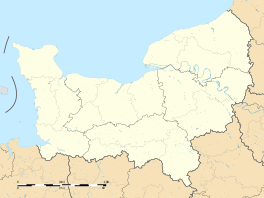Condé-sur-Noireau
| Condé-sur-Noireau | ||
|---|---|---|
 |
||
|
||
| Coordinates: 48°51′N 0°33′W / 48.85°N 0.55°WCoordinates: 48°51′N 0°33′W / 48.85°N 0.55°W | ||
| Country | France | |
| Region | Normandy | |
| Department | Calvados | |
| Arrondissement | Vire | |
| Canton | Condé-sur-Noireau | |
| Intercommunality | Condé | |
| Government | ||
| • Mayor (2008–2014) | Pascal Allizard | |
| Area1 | 12.53 km2 (4.84 sq mi) | |
| Population (2008)2 | 5,611 | |
| • Density | 450/km2 (1,200/sq mi) | |
| Time zone | CET (UTC+1) | |
| • Summer (DST) | CEST (UTC+2) | |
| INSEE/Postal code | 14174 /14110 | |
| Elevation | 72–173 m (236–568 ft) (avg. 84 m or 276 ft) |
|
|
1 French Land Register data, which excludes lakes, ponds, glaciers > 1 km² (0.386 sq mi or 247 acres) and river estuaries. 2Population without double counting: residents of multiple communes (e.g., students and military personnel) only counted once. |
||
1 French Land Register data, which excludes lakes, ponds, glaciers > 1 km² (0.386 sq mi or 247 acres) and river estuaries.
Condé-sur-Noireau is a former commune in the Calvados department in the Normandy region in northwestern France. On 1 January 2016, it was merged into the new commune of Condé-en-Normandie. It is situated on the Noireau River. In the fifteenth century, the town was occupied by the English, and belonged to Sir John Fastolf of Caister Castle in Norfolk (1380-1459). It was from here that the Spanish mercenary Francois de Surienne launched an attack on Fougeres in Brittany, which triggered the invasion of English Normandy by Charles VII of France, and the end of the Hundred Years' War.
The commune is twinned with:
...
Wikipedia



